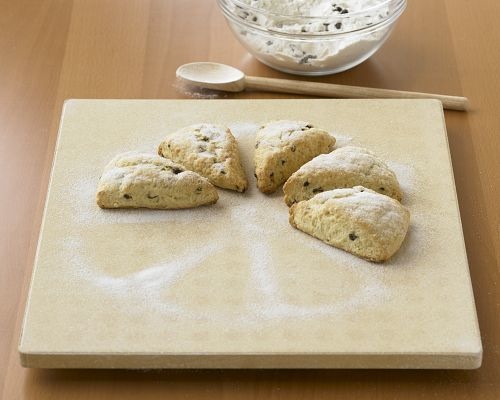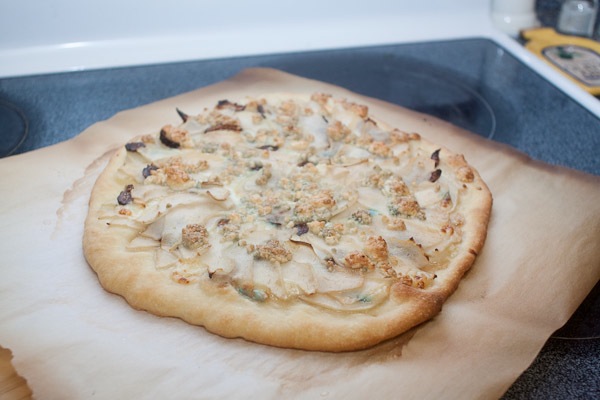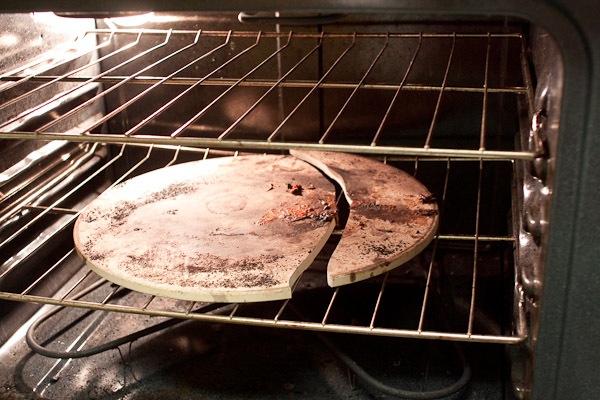We lost a good friend a couple days ago… our pizza stone. It had survived 2 moves and plenty of good bread baking and pizza making. I think what may have finally done it in was a leaking calzone. I tried making calzone and I made the second one up too soon so the dough became soaked and the tomato sauce and cheese escaped. When the wet tomato hit the super hot stone, it cracked.
One of the things I love/hate about cookware is the infinite variants on products, each supposedly superior. Even better than the variety of offerings is the fan club each attracts, who are willing to duke it out over which product is superior. Pizza stones are no exception!
I think I got my old pizza stone from the now defunct Linens n’ Things for a princely sum of somewhere around $14. This was back before I thought to check the internet to see what was available. Apparently you can get entire kits that turn your oven into a hearth by lining it with baking stones.
For normal baking/pizza stones there are a couple of options. You have your basic ceramic, 14″ round pizza stone, like the one I started out with. It is pretty light weight and the material it is made out of isn’t the strongest. That said, the one I had lasted me over 5 years so they do work pretty well. You can also just used unglazed quarry tiles from Home Depot. They are cheap enough to outweigh any problems. I haven’t tried that route, but a quick google should set you straight.
Weight is a big deal. In general, the heavier something is, the better it holds heat. This means that when you put in a wet, relatively cooler pizza, a heavier stone will not cool off as much and remain hotter. The only problem is that heavier things also take longer to heat up. It is similar to moving a heavy object, it takes more energy to get it moving, but once it is going it takes more to also stop it.
Of course being driven by American consumer culture, I had to upgrade my pizza stone instead of simply getting another generic one. In the premium pizza stone world there are two different camps. On one side are stones made out of Fibrament and on the other are stones made with a high strength ceramic, Cordierite, that is used inside of pottery kilns.

I am not going to get into which option for these high end stones is better. There is a great thread here where participants do a much a better job than I could. If you are interested in a Fibrament stone, their site is here. There are a number of options for Cordierite stones. Cook’s Illustrated choose a Cordierite baking from Old Stone Oven as their favorite, although the Fibrament came in a close second. There are a number of different people selling the Old Stone Oven one, including Amazon and King Arthur . I ended up just buying it from Williams Sonoma because it didn’t have to worry about it breaking during shipping, apparently a problem with Amazon. The factor that won me over though was that it has a lifetime guarentee from Williams Sonoma that it won’t crack and I can just bring it back to the store for an easy exchange if it is; much better than having to worry about shipping.
I have only had a chance to use it once due to DC’s currently oppresive heat, but I will update this as I get to use it more. The pizza (fig, caramelized onion, pear and blue cheese!) I tried on it came out fantastic, so no regrets yet!


Love your web site and the great information. I live in the Philippines and in many cases an oven is not common. So, I had a Weber Kettle shipped to me from the US and am now in heaven and am learning to use it as an oven. A pizza stone would be awesome. Any suggestions to get something shipped here or better yet find one here. LOL!
Hi there. I was researching pizza stones, but I have forgotten why I wanted one. There are sooo many sites, and clicking this one and that one made me forget my reason for even wanting a pizza stone! But I just wanted to say that out of the 20 or more sites I visited, yours was the most informative. Now if I could only remember why I needed or wanted one since I already own a small rectangular one … ;-)
Luckily, my trusty ol’ pizza stone has lasted… over 40 years now! Bought it (actually have two) back in ’69. They were made in a Chicago suburb where I now live. Company folded long ago.
This baby is an inch thick (varies in areas) and weighs in at 12½ pounds. Ugly, but works great. Never been able to find anything like it.
I have a PC rectangular baking stone, but the pizza crust always comes out soggy (i use Trader Joe’s readymade crust). Any suggestions? Should I make sure the stone is good and hot before putting the dough on it? Should I pre-cook the crust before adding the toppings?
Making sure it gets good and hot is always a good idea. I do like to pre-cook the crust for 8 minutes or so if I am going to be adding lots of topping. Also try reducing the amount of tomato sauce. If the toppings are too wet there is not chance for the crust to cook through before the cheese burns.
Hi – I used to sell Pampered Chef products about 12 years ago and am still using most of my original stoneware. In fact my rectangular stone is nearly black (and well seasoned) from years of constant use. Just wanted to mention that the PC stoneware is good quality at reasonable prices.
Love your blog and your daughter is gorgeous!
Thanks Meggie!
That is good to hear. I saw a bunch of other people who were really happy with their Pampered Chef stones when I was searching around.
It’s pretty cool that you can snag a stone for a decent price. Makes homemade pizza eating even more fun. Can’t believe yours was cracked by a tomato, but at least you’re ready to try more pizzas!